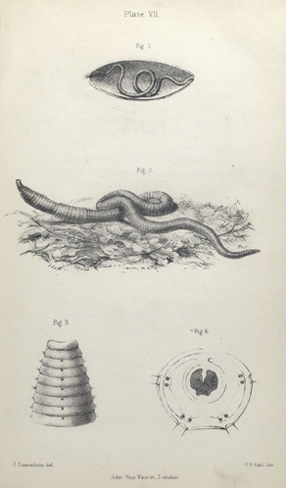

• Intro / Home
• Historical Neighbors
• Street and Backyard
Neighbors
• Park and Green Places
Neighbors
• Shore and Wetlands
Neighbors
• Salt and Freshwater
Neighbors
• Tiny Neighbors
• Unwelcome Neighbors
• Occasional and
Unexpected Neighbors
•
Wildlife Sighting Log
• Resources
• Hours and Tours
• Press Release
• NYPL HOME
| Tiny Neighbors | |
In addition to the adult worm, the author/artist has depicted its anterior rings (Fig. 3), a cross section (Fig. 4), and an emergent hatchling (Fig. 1). Wherever a plant grows in the city, the Common Earthworm is present, eating its way through the soil, which it aerates and fertilizes with undigested castings. Arguably one of our least-noticed and least-appreciated urban neighbors, the earthworm is also one of the most resilient. Just days after the horrors of September 11, 2001, Battery Park City Park Conservancy gardeners discovered that many plants remained alive under the ashes in the Esplanade and other gardens near Ground Zero. And under the soil below the ashes, earthworms were found, unaffected by the devastation above. |
